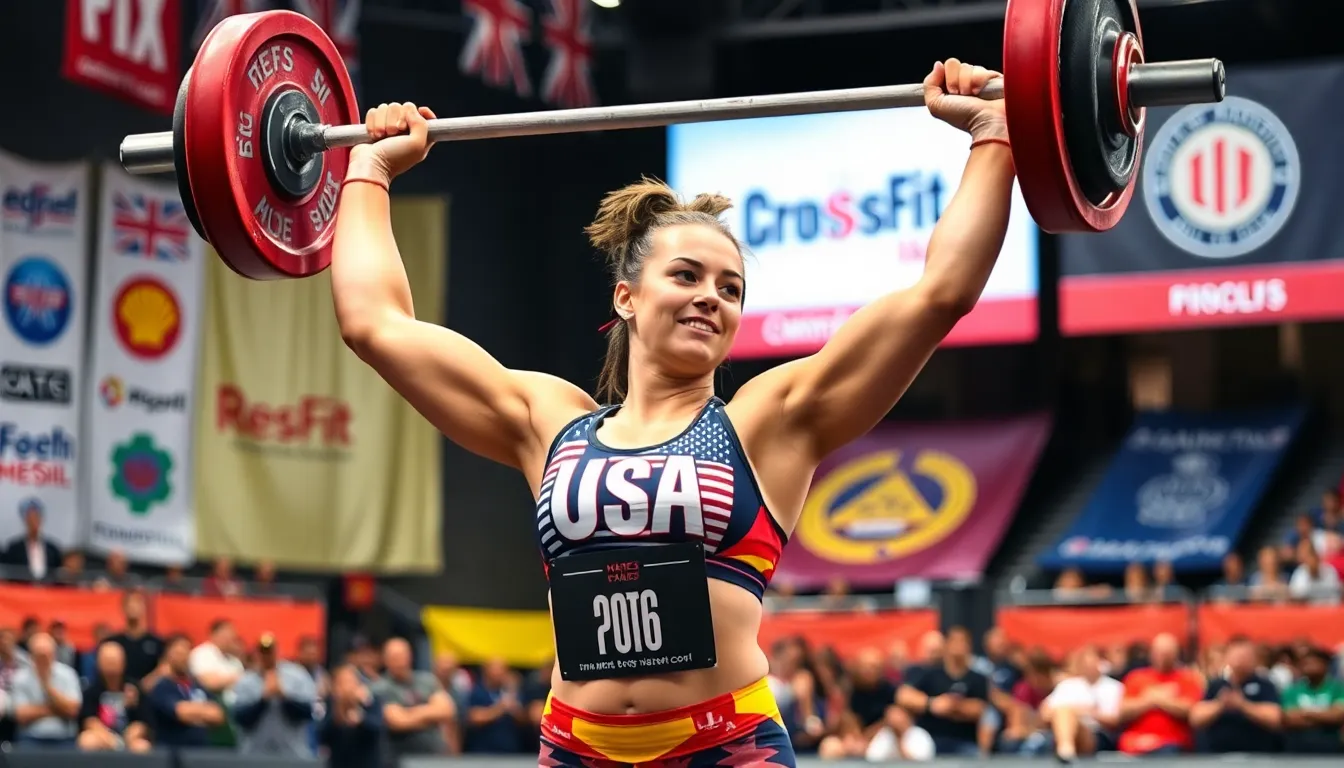In recent years, workout competitions have surged in popularity, attracting fitness enthusiasts from all walks of life. These events not only showcase incredible athleticism but also foster a sense of community among participants. From CrossFit challenges to bodybuilding contests, individuals push their limits and redefine what’s possible in the realm of fitness.
As competitors train rigorously to prepare for these events, they often discover newfound motivation and discipline. The thrill of competition drives them to achieve personal bests and connect with like-minded individuals. Whether one is a seasoned athlete or a newcomer to the fitness scene, workout competitions provide a unique platform to celebrate hard work, dedication, and the pursuit of excellence.
Table of Contents
ToggleOverview of Workout Competitions
Workout competitions encompass a variety of events designed to test physical skills and mental grit. These competitions attract fitness enthusiasts eager to challenge themselves and showcase their progress. Popular formats include CrossFit challenges, bodybuilding contests, powerlifting meets, and obstacle course races.
Key Components
- Assessment of Skill Levels: Competitions evaluate strength, endurance, flexibility, and overall fitness through a series of events.
- Diverse Categories: Participants can compete in categories such as age, weight class, and skill level, allowing for a fair competition environment.
- Scoring Systems: Events use different scoring systems to rank competitors based on performance metrics like time, weight lifted, or points earned.
Benefits of Participation
- Enhanced Motivation: Participants often experience a surge in motivation leading up to competitions, driving them to improve their workout routines.
- Community Building: Competitions foster a sense of belonging among fitness enthusiasts, creating lasting friendships and networks.
- Goal Achievement: Individuals set and reach specific goals, enabling personal growth and heightened confidence in their abilities.
Popular Competition Types
- CrossFit Competitions: Focus on a combination of weightlifting, running, and gymnastics skills; commonly held locally and regionally.
- Bodybuilding Shows: Judges evaluate competitors based on muscle development, symmetry, and stage presence.
- Powerlifting Events: Contestants compete in three main lifts: squat, bench press, and deadlift, measuring raw strength.
Workout competitions not only challenge physical capabilities but also promote camaraderie among participants. They serve as venues for athletes to demonstrate their commitment to fitness while enjoying the process of competition.
Types of Workout Competitions

Various types of workout competitions cater to diverse athletic skills and interests. Each format focuses on specific physical challenges that allow participants to excel.
CrossFit Competitions
CrossFit competitions emphasize diverse workouts that test strength, stamina, and agility. Events often include functional movements like weightlifting, gymnastics, and high-intensity cardio. Participants compete in various rounds, facing time-based or scored challenges. Examples include the CrossFit Games, which features top athletes competing for prizes and recognition in multiple categories.
Powerlifting Meets
Powerlifting meets focus on three primary lifts: the squat, bench press, and deadlift. Competitors aim for maximum weight in each discipline, with their best lifts combined for a total score. These events promote strength and technique while often including weight classes to ensure fair competition. Federations, like the International Powerlifting Federation (IPF), govern powerlifting meets to maintain standardized rules.
Strongman Events
Strongman events challenge competitors with unique tasks that test raw strength and endurance. Common challenges include the Atlas stones, tire flips, and log lifts. Participants work against time or weight, showcasing their physical prowess in various tasks. Events often have different weight categories, catering to male and female athletes at all levels. Strongman competitions, such as World’s Strongest Man, draw significant attention due to their intense nature and diverse skill sets.
Benefits of Participating in Workout Competitions
Participating in workout competitions offers numerous advantages that enhance both physical and mental well-being.
- Increased Motivation: Competing provides a sense of urgency that often spurs individuals to train harder. When facing rivals, many find an extra push to improve their performance, leading to better workout routines and physical outcomes.
- Sense of Community: Workout competitions foster camaraderie among participants. Competitors often build lasting friendships, share experiences, and support each other, creating a strong community that encourages continued participation in fitness activities.
- Goal Achievement: Setting specific targets before a competition can significantly enhance focus and determination. Achieving personal bests during competitions instills a sense of accomplishment and encourages further goal-setting.
- Enhanced Discipline: Regular training for a competition promotes a disciplined lifestyle. Athletes adopt structured routines around their workouts and nutrition, leading to better overall health and fitness.
- Skill Development: Engaging in diverse competitive formats helps participants hone various physical skills. From strength training to endurance challenges, athletes develop a well-rounded fitness foundation.
- Networking Opportunities: Competitors within these events connect with like-minded individuals and experts in the fitness community, providing opportunities for collaboration and shared growth.
- Recognition and Exposure: Achievements in competitions can lead to recognition within the fitness community, boosting self-esteem and potentially opening doors for sponsorships or coaching opportunities.
By embracing the challenges of workout competitions, individuals gain more than just physical benefits; they cultivate a holistic approach to fitness that encompasses motivation, community, discipline, and personal growth.
Preparing for a Workout Competition
Preparation for a workout competition involves rigorous training, proper nutrition, and effective recovery strategies. These elements contribute significantly to overall performance and competitive success.
Training Regimens
Training regimens vary based on competition type and individual fitness levels. A structured approach enhances physical capacity and mental preparation. Here are key considerations for developing an effective training regimen:
- Periodization: Implement a structured plan breaking training into cycles focused on building strength, endurance, and skill. This approach optimizes performance by allowing recovery and adaptation.
- Specificity: Tailor workouts to mimic competition conditions. For CrossFit, include varied high-intensity workouts; for powerlifting, emphasize the squat, bench press, and deadlift with progressive overload.
- Strength Training: Incorporate compound movements to build overall strength. Exercises like squats, deadlifts, and overhead presses are essential for powerlifting and strongman competitions.
- Endurance Work: Integrate cardiovascular training for events requiring stamina. Activities such as running, cycling, or rowing enhance aerobic capacity.
- Skill Drills: Practice competition-specific skills regularly. Whether performing complex movements or strategizing for obstacle course races, mastering techniques is crucial.
Nutrition and Recovery
Nutrition and recovery play essential roles in maximizing performance. Proper management of both elements ensures competitors stay energized and injury-free. Key factors to consider include:
- Macronutrient Balance: Focus on a diet rich in carbohydrates, proteins, and healthy fats. Carbohydrates provide energy, proteins support muscle repair, and fats aid in hormone production and overall health.
- Hydration: Prioritize hydration to maintain peak physical function. Dehydration negatively impacts performance, so drink water consistently throughout training and competition.
- Meal Timing: Consume meals and snacks that align with training schedules. Eating a balanced meal two to three hours before workouts ensures optimal energy levels, while quick sources of protein or carbs post-workout aid recovery.
- Rest Days: Schedule regular rest days to allow for muscle recovery and overall mental rejuvenation. Incorporate active recovery strategies, such as light cardio or stretching, to keep blood flow active.
- Sleep: Aim for 7-9 hours of quality sleep nightly. Adequate rest is vital for physical recovery, cognitive function, and immune health, all contributing to optimal performance.
Focusing on training regimens, nutrition, and recovery creates a comprehensive preparation strategy for workout competitions.
Popular Workout Competitions Around the World
Numerous workout competitions capture the attention of fitness enthusiasts globally. These events showcase diverse athletic skills while fostering a strong sense of community among participants.
CrossFit Competitions
CrossFit competitions challenge athletes with various workouts that test strength, endurance, and agility. Events include functional movements such as Olympic lifts, gymnastics elements, and cardio-based challenges. The scoring system typically ranks competitors based on overall performance across multiple workouts.
Bodybuilding Contests
Bodybuilding contests focus on physique development, evaluating competitors’ muscle definition, symmetry, and presentation. Participants undergo extensive training and dietary regimens to achieve peak condition for the stage. Judging criteria are based on several categories, including classic physique, men’s and women’s bodybuilding, and fitness.
Powerlifting Meets
Powerlifting meets emphasize three core lifts: squat, bench press, and deadlift. Competitors aim for maximum weight in each lift, with the total combined weight determining their ranking. Events often include weight class categories to ensure fair competition among participants of varying sizes.
Strongman Events
Strongman competitions test athletes’ strength and endurance through unique, heavy tasks. Common challenges include lifting Atlas stones, flipping tires, and carrying yokes. These events require a mix of brute strength and technique, appealing to athletes who enjoy unconventional workouts.
Obstacle Course Races
Obstacle course races (OCR) combine running with various physical challenges, such as climbing walls, crawling under barriers, and traversing balance beams. Participants compete for the fastest time while tackling demanding obstacles. OCR events attract diverse competitors, ranging from casual participants to elite athletes.
Endurance Events
Endurance events, such as triathlons and ultramarathons, test athletes’ stamina across long distances. Competitors often undergo extensive training in swimming, cycling, and running to prepare. These events allow participants to challenge their limits and achieve personal milestones.
Each of these workout competitions contributes to the growing fitness culture worldwide. The diverse formats ensure that individuals can find events aligning with their interests and skill levels, encouraging participation and fostering community engagement.
Workout competitions serve as a powerful catalyst for personal growth and community building. They not only challenge individuals to push their physical and mental limits but also create lasting connections among participants. The structured environment of these events fosters motivation and discipline, helping competitors achieve their fitness goals.
As the popularity of these competitions continues to rise, more people are discovering the benefits of participating in various formats. From CrossFit to powerlifting and strongman events, there’s something for everyone. Engaging in these competitions cultivates a supportive atmosphere where hard work and dedication are celebrated, enriching the overall fitness experience.




